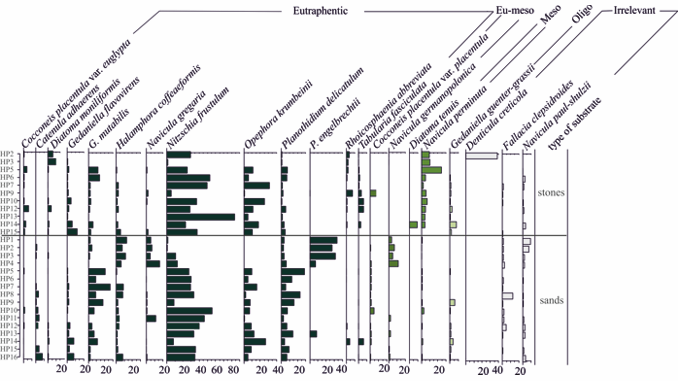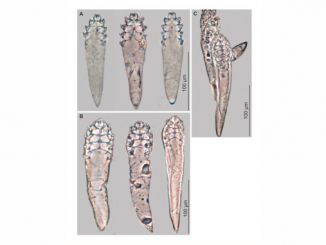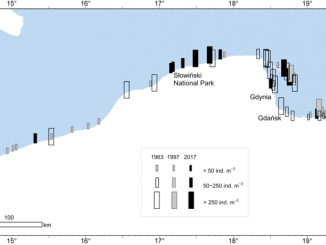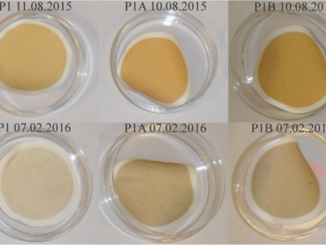
Paper category: Original research paper
Corresponding author: Małgorzata Witak (malgorzata.witak@ug.edu.pl)
DOI: 10.1515/ohs-2020-0027
Received: 03/01/2020
Accepted: 07/04/2020
Full text: here
Citation (APA style): Oceanological and Hydrobiological Studies, Volume 49, Issue 3, Pages 304–318, eISSN 1897-3191, ISSN 1730-413X, DOI: https://doi.org/10.1515/ohs-2020-0027.
Abstract
The paper presents the results of the analysis of diatoms from surface sediments (stones, sands) and macroflora (seagrass, macroalgae) collected at 16 sampling sites located along the inner coastal zone of Puck Bay (southern Baltic Sea) along the Hel Peninsula. The main diatom species of epilithon, epipsammon and epiphyton were characterized with respect to their autecological preferences (habitat, salinity, trophic status, saprobity). Three groups of diatoms were distinguished with respect to the type of substrate based on the results of benthic flora analysis: diatoms (i) of one type of substrate, (ii) of two types and (iii) those occurring on all types of substrates. Moreover, the distribution of benthic diatom communities indicates ecological differences in the study area. Marine and brackish-water species were observed in large numbers in the coastal zone of the Outer Puck Bay, whereas freshwater flora occurred with a higher frequency in the coastal zone of the Puck Lagoon. The content of polysaprobionts and of α-mesosaprobionts indicates that the region of the Hel Tip is highly eutrophicated and very polluted. The coast in the vicinity of Kuźnica is less polluted, whereas the best environmental conditions are found in the Jurata–Jastarnia region, as evidenced by the frequency of diatoms that are β-mesosaprobionts.
References
Andrulewicz, E. & Witek, Z. (2002). Anthropogenic Pressure and Environmental Effects on the Gulf of Gdansk: Recent Management Efforts. In G. Schernewski & U. Schiewer (Eds.), Baltic coastal ecosystems, structure, function and coastal zone management. Central and Eastern European Development Studies (pp. 119–139). Berlin: Springer Verlag.
Battarbee, R.W. (1986). Diatom analysis. In B.E. Berglund (Ed.), Handbook of Holocene Palaeoecology and Palaeohydrology (pp. 527–570). London: John Wiley and sons. Ltd.
Bodén, P. (1991). Reproducibility in the Random Settling Method for Quantitative Diatom Analysis. Micropaleontology 37(3): 313–319. DOI: 10.2307/1485893.
Bogaczewicz-Adamczak, B. & Dziengo, M. (2003). Using benthic communities and diatom indices to assess water pollution in the Puck Bay (southern Baltic Sea) littoral zone. Oceanological and Hydrobiological Studies 32(4): 131–157.
Bogaczewicz-Adamczak, B. & Żukowska, A. (1990). Okrzemki kopalne z osadów w Juracie (Fossil diatoms from sediments of Jurata). Przewodnik 61 Zjazdu PTG. 71-74.
Bogaczewicz-Adamczak, B. (1982). Novyi diatomovyi analiz osadotchnoy tolshtchi Gelskogo Poluostrova (New diatom data from the sediments of the Hel Peninsula). Peribalticum. 2: 185–193. (In Russian).
Bohr, R. & Sokół, M. (1972). The fossil diatom flora from the sediments of the Hel Peninsula. International Conference in Poland, 22–26 September 1972 (pp. 20–23). Sopot, Poland: Guide – Book of excursion.
Bolałek, J., Falkowska, L. & Korzeniewski, K. (1993). Substancje biogeniczne (Biogenic nutrients). In K. Korzeniewski (Ed.), Zatoka Pucka (The Puck Bay) (pp. 262–279). Fundacja Rozwoju Uniwersytetu Gdańskiego. (In Polish).
Denys, L. (1991). A check-list of the diatoms in the Holocene deposits of the western Belgian coastal plain with a survey of their apparent ecological requirements. I. Introduction, ecological code and complete list. Professional Paper Belgium Geological Survey 246: 1–41.
Dybowski, D., Jakacki, J., Janecki, M., Nowicki, A., Rak, D. et al. (2019). High-Resolution Ecosystem Model of the Puck Bay (Southern Baltic Sea) – Hydrodynamic Component Evaluation. Water 11(10): 2057. DOI: 10.3390/w11102057.
Dziengo-Czaja, M., Koss, J. & Matuszak, A. (2008). Teratological forms of diatoms (Bacillariophyceae) as indicators of water pollution in the western part of Puck Bay (southern Baltic Sea). Oceanological and Hydrobiological Studies 37(2): 119–132. DOI: 10.2478/v10009-007-0042-1.
Fronczak, M. & Pliński, M. (1982). Ecological characteristic of fouling microflora in Puck Bay. Zeszyty Naukowe UG. Oceanografia 9: 49–64.
Grimm, E.C. (2011). Tilia Version 2.0.37 (software). Springfield, IL: Illinois State Museum.
Hustedt, F. (1927–1966). Die Kieselalgen Deutschlands, Österreichs und der Schweiz 1-3. In Dr. L. Rabenhorsts (Ed.), Kryptogamenflora von Deutschland, Österreich und der Schweiz 7. Leipzig: Akademische Verlerlagsbuchhandlung.
Kramarska, R. (1995). Superficial bottom sediments. Pl. XXIV. In R. Dadlez, J.E. Mojski, B. Słowańska, S. Uścinowicz & J. Zachowicz (Eds), Geological atlas of the Southern Baltic, 1:500 000. Sopot – Warszawa: Państwowy Instytut Geologiczny.
Krammer, K. & Lange-Bertalot, H. (1986). Bacillariophyceae. 1. Teil: Naviculaceae. In H. Ettl, J. Gerloff, H. Heynig & D. Mollenhauer (Eds.), Süßwasserflora von Mitteleuropa 2/1 (pp. 876). G. Fischer, Stuttgart & New York.
Krammer, K. & Lange-Bertalot H. (1988). Bacillariophyceae. 2. Teil: Bacillariaceae, Epithemiaceae, Surirellaceae. In H. Ettl, J. Gerloff, H. Heynig & D. Mollenhauer (Eds.), Süßwasserflora von Mitteleuropa 2/2 (pp. 596). G. Fischer, Stuttgart & New York.
Krammer, K. & Lange-Bertalot H. (1991a). Bacillariophyceae. 3. Teil: Centrales, Fragilariaceae, Eunotiaceae. In H. Ettl, J. Gerloff, H. Heynig & D. Mollenhauer (Eds.), Süßwasserflora von Mitteleuropa 2/3 (pp. 576). G. Fischer, Stuttgart & Jena.
Krammer, K. & Lange-Bertalot, H. (1991b). Bacillariophyceae. 4. Teil: Achnanthaceae. Kritische Ergänzungen zu Navicula (Lineolatae) und Gomphonema. Gesamtliteraturverzeichnis. Teil 1-4. In H. Ettl, G. Gärtner, J. Gerloff, H. Heynig & D. Mollenhauer (Eds.), Süßwasserflora von Mitteleuropa 2/4 (pp. 437). Fischer, Stuttgart & Jena.
Kruk-Dowgiałło, L. & Szaniawska, A. (2008). Gulf of Gdańsk and Puck Bay. In U. Schiewer (Ed.) Ecology of Baltic Coastal Waters. Ecological Studies (Analysis and Synthesis) vol 197, (pp. 139–165). Springer, Berlin, Heidelberg. DOI: 10.1007/978-3-540-73524-3_7.
Krzyminski, W., Kruk-Dowgiałło, L., Zawadzka-Kahlau, E., Dubrawski, R., Kamińska, M. et al. (2004). Typology of Polish marine waters. In G. Schernewski & M. Wielgat (Eds.), Baltic Sea Typology Coastline Reports 4 (pp. 39–48). Warnemünde: The Coastal Union – Die Küsten Union Deutschland.
Lange-Bertalot, H. (2001). Navicula sensu stricto. 10 Genera Separated from Navicula sensu lato, Frustulia. In H. Lange-Bertalot (Ed.), Diatoms of Europe 2 (pp. 526). A.R.G. Gantner Verlag K.G., Ruggell.
Leśniewska, M. & Witak, M. (2008). Holocene diatom biostratigraphy of the SW Gulf of Gdańsk, Southern Baltic Sea (part III). Oceanological and Hydrobiological Studies 37(4): 35–52. DOI: 10.2478/v10009-008-0017-x.
Leśniewska, M. & Witak, M. (2011). Diatoms as indicators of eutrophication in the western part of the Gulf of Gdańsk, Baltic Sea. Oceanological and Hydrobiological Studies 40(1): 68–81. DOI: 10.2478/s13545-011-0008-5.
Li, Chun L., Witkowski, A., Ashworth M.P., Dąbek, P., Sato, S. et al. (2018). The morphology and molecular phylogenetics of some marine diatom taxa within the Fragilariaceae, including twenty undescribed species and their relationship to Nanofrustulum, Opephora and Pseudostaurosira. Phytotaxa. 355 (1): 1–104. DOI: 10.11646/phytotaxa.355.1.1.
Majewska, R., Zgrundo, A., Lemke, P. & De Stefano, M. (2012). Benthic diatoms of the Vistula River estuary (Northern Poland): Seasonality, substrata preferences, and the influence of water chemistry. Phycological Research 60(1): 1–19. DOI: 10.1111/ j.1440-1835.2011.00637.x.
Nowacki, J. (1993). Termika, zasolenie i gęstość wody (Thermal state, salinity and water density). In K. Korzeniewski (Ed.), Zatoka Pucka (The Puck Bay). (pp. 79–112). Fundacja Rozwoju Uniwersytetu Gdańskiego. (In Polish).
Nowacki, J., Matciak, M., Szymelfenig, M. & Kowalewski, M. (2009). Upwelling characteristics in the Puck Bay (the Baltic Sea). Oceanological and Hydrobiological Studies 38(2): 3–16. DOI: 10.2478/v10009-009-0014-8.
Obarska-Pempkowiak, H., Gajewska, M., Wojciechowska, E. & Pempkowiak, J. (2015). Treatment Wetlands for Environmental Pollution Control. In P. Rowiński (Ed.), GeoPlanet: Earth and Planetary Sciences (pp. 1–168). Switzerland: Springer International Publishing.
Pankow, H. (1990). Ostsee – Algenflora. Fischer, Jena.
Pędziński, J. & Witak, M. (2019). Evidence of cultural eutrophication of the Gulf of Gdańsk based on diatom analysis. Oceanological and Hydrobiological Studies 48(3): 247–261. DOI: 10.2478/ohs-2019-0022.
Pliński, M. (1975). The algae in the surface water of the Bay of Puck (Baltic) in the vegetation period of 1972. Botanica Marina 18: 183–186. DOI: 10.1515/botm. 1975.18.3.183.
Pliński, M. (1979). Kierunki zmian strukturalnych w fitoplanktonie estuariów Bałtyku Południowego (Tendency of structural changes in the phytoplankton of the Southern Baltic estuaries]). Rozprawy i Monografie UG 15: 1–136. (In Polish).
Pliński, M. (1982). Rozmieszczenie i biomasa fitobentosu Zatoki Puckiej wewnętrznej (Distribution and biomass of phytobenthos of the Inner Puck Bay). Studia i Materiały Oceanologiczne 39: 53–68. (In Polish).
Pliński, M. (1987). Roślinność (Flora). In B. Augustowski (Ed.), Bałtyk Południowy (Southern Baltic) (pp. 321–346). Warszawa, Kraków, Gdańsk, Łódź: Wydawnictwo PAN Wrocław. (In Polish).
Pliński, M. (1990). Important ecological features of the Polish coastal zone of the Baltic Sea. Limnologica 20: 39–45.
Pliński, M. & Florczyk, I. (1984). Changes in the phytoplankton resulting from the eutrophication of the Puck Bay. Limnologia 15: 325–327.
Pliński, M. & Florczyk, I. (1993) Macrophytobenthos. In K. Korzeniewski (Ed.), The Bay of Puck (pp. 281–302). Gdańsk: University of Gdańsk (In Polish).
Pliński, M. Florczyk, I. & Picińska, J. (1985). Skład i liczebność fitoplanktonu Zatoki Gdańskiej Właściwej (The composition and abundance of phytoplankton in the Gulf of Gdańsk Proper). Studia i Materiały Oceanologiczne 46: 23–64. (In Polish with English summary).
Pliński, M & Kwiatkowski, J. (1996). Microphytobenthos of the shallow littoral of the southern Baltic. Oceanological Studies 4: 65–77.
Pliński, M., Sobolewska, B. & Mielczarek M. (1982). Skład i liczebność fitoplanktonu zachodniej częśći Zatoki Gdańskiej (The composition and abundance of phytoplankton in the western part of Gdańsk Bay). Studia i Materiały Oceanologiczne 39: 35–75. (In Polish with English Summary).
Reindl, A.R. & Bolałek, J. (2012). Methane flux from sediment into nearbottom water in the coastal area of the Puck Bay (Southern Baltic). Oceanological and Hydrobiological Studies 41(3): 40–47. DOI: 10.2478/s13545-012-0026-y.
Robakiewicz, M. (2014). Salinity changes in the Bay of Puck due to brine discharge based on in-situ measurements. Oceanological and Hydrobiological Studies 43(2): 191–199. DOI: 10.2478/s13545-014-0133-z.
Rönnberg, C. & Bansdorff, E. (2004). Baltic Sea eutrophication: area-specific ecological consequences. Hydrobiologia 514: 227–241. DOI: 10. 1023/B:HYDR.0000019238.84989.7f.
Sandegren, R. (1935). O kopalnej mikroflorze z wiercenia na Helu i o zmianach postglacjalnych poziomu Bałtyku (Fossil microflora from the borehole at Hel and postglacial changes of the Baltic level). Sprawozdania PIG 8: 51–63. (In Polish).
Schrader, H. & Gersonde, R. (1978). Diatoms and silicoflagellates in the eight meters sections of the lower Pleistocene at Capo Rossello. Utrecht Micropaleontological Bullietin 17: 129–176.
Schulz, P. (1926). Die Kieselalgen der Danziger Bucht mit Einschluss derjenigen aus glazialen und postglazialen Sedimenten. Botanisches Archiv. 13: 149–327.
Snoeijs, P. (1993). Intercalibration and distribution of diatom species in the Baltic Sea. The Baltic Marine Biologist Publication, I. 16a. Uppsala: Opulus Press.
Snoeijs, P. & Balashova, N. (1998). Intercalibration and distribution of diatom species in the Baltic Sea. The Baltic Marine Biologist Publication, I. 16e. Uppsala: Opulus Press.
Snoeijs, P. & Kasprovičiene, J. (1996). Intercalibration and distribution of diatom species in the Baltic Sea. The Baltic Marine Biologist Publication, I. 16d. Uppsala: Opulus Press.
Snoeijs, P. & Potapova, M. (1995). Intercalibration and distribution of diatom species in the Baltic Sea. The Baltic Marine Biologist Publication, I. 16c. Uppsala: Opulus Press.
Snoeijs, P. & Vilbaste, S. (1994). Intercalibration and distribution of diatom species in the Baltic Sea. The Baltic Marine Biologist Publication, I. 16b. Uppsala: Opulus Press.
Stelmaszyk-Świerczyńska, A. & Małkiewicz, A. (2014). Przystań Rybacka w Kuźnicy – najnowszy „port” Rzeczypospolitej (The Fishing Harbour in Kuźnica – the newest „port” of the Republic of Poland). Inżynieria Morska i Geotechnika 4: 314–326.
Tomczak, A. (1995). Relief, geology and evolution of the Hel Spit. In K. Rotnicki (Ed.), Polish Coast: Past, Present and Future (pp. 181–186). Journal of Coastal Research Special Issue, 22.
Trzosińska, A. (1990). Nitrogen and phosphorus compounds. In A. Majewski (Ed.), The Gulf of Gdańsk (pp. 275–291). Warszawa. Wyd. Geol. (In Polish).
Uścinowicz, S. (2003). Relative sea level changes, glaco-isostatic rebound and shoreline displacement in the Southern Baltic. Polish Geological Institute Special Papers 10: 1–79.
van Dam, H., Mertens, A. & Sinkeldam, J. (1994). A coded checklist and ecological indicator values of freshwater diatoms from the Netherlands. Netherlands Journal of Aquatic Ecology 28: 117–133.
Vos, P.C. & de Wolf, H. (1993). Diatoms as a tool for reconstructing sedimentary environments in coastal wetlands; methodological aspects. Hydrobiologia 269/270: 285–296.
Warzocha, J., Gromisz, S., Wodzinowski, T. & Szymanek, L. (2018). The structure of macrozoobenthic communities as an environmental status indicator in the Gulf of Gdańsk (the Outer Puck Bay). Oceanologia 60(4): 553–559. DOI: 10.1016/j.oceano.2018.05.002.
Witak, M. (2000). A diatom record of Late Holocene environmental changes in the Gulf of Gdańsk. Oceanological Studies 19(2): 57–74.
Witak, M. (2001). A Late Glacial diatom flora from lacustrine sediments of Puck Bay, Southern Baltic Sea, Poland. In R. Jahn, J.P. Kociolek, A. Witkowski & P. Compère (Eds.), Lange-Bertalot-Festschrift Studies on diatoms (pp. 457–475). Ganter, Rugell.
Witak, M. (2002). Postglacial history of the development of the Puck Lagoon (The Gulf of Gdańsk, Baltic Sea) based on the diatom flora. In A. Witkowski (Ed.), Diatom Monographs 2 (pp. 173). Ruggell: A.R.G. Gantner Verlag K.G.
Witak, M. (2010). Application of diatom biofacies in reconstructing the evolution of sedimentary basins. Records from the southern Baltic Sea differentiated by the extent of the Holocene marine transgressions and human impact. In A. Witkowski (Ed.), Diatom Monographs 12 (pp. 295). Ruggell, Liechtenstein: A.R.G. Gantner Verlag K.G.
Witak, M. (2013). A review of the diatom research of the Gulf of Gdańsk and Vistula Lagoon (southern Baltic Sea). Oceanological and Hydrobiological Studies 42(3): 336–346. DOI: 10.2478/s13545-013-0091-x.
Witak, M. & Dunder, J. (2007). Holocene diatom biostratigraphy of the SW Gulf of Gdańsk, Southern Baltic Sea (part II). Oceanological and Hydrobiological Studies 36(3): 3–20. DOI: 10.2478/v10009-007-0021-6.
Witak, M., Jankowska, D. & Piekarek-Jankowska, H. (2006). Holocene diatom biostratigraphy of the SW Gulf of Gdańsk, Southern Baltic Sea (part I). Oceanological and Hydrobiological Studies 35(4): 307–329.
Witak, M. & Pędziński, J. (2018). The diatom record of progressive anthropopressure in the Gulf of Gdańsk and the Vistula Lagoon. Oceanological and Hydrobiological Studies 47(2): 167–180. DOI: 10.1515/ohs-2018-0016.
Witkowski, A. (1990). Fossilization processes of the microbial mat developing in clastic sediments of the Puck Bay (Southern Baltic Sea). Acta Geologica Polonica 40(1–2): 1–27.
Witkowski, A. (1991). Diatoms of the Puck Bay coastal shallows (Poland, Southern Baltic). Nordic Journal of Botany 11: 689–701. DOI: 10.1111/j.1756-1051.1991.tb 01280.x.
Witkowski, A. (1994). Recent and fossil diatom flora of the Gulf of Gdańsk, Southern Baltic Sea. Biblitheca Diatomologica,
Witkowski, A., Lange-Bertalot, H. & Metzeltin, D. (2000). Diatom flora of marine costs I. Iconographica Diatomologica 7 (pp. 925). ARG Gantver Verlag KG.




Bądź pierwszy, który skomentuje ten wpis